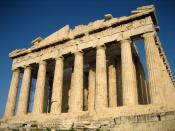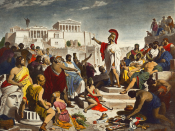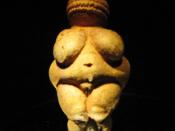The earliest types of sculpture were fertility goddesses similar to the 'Venus' of Willendorf, which is thought to date from between 24,000-22,000 BCE. They were only large enough to fit in the hand as the earliest civilizations were nomadic and could not carry large statues around with them, nor did they have the skills to make them. The figures had overly large stomachs and breasts showing that the importance of women at that time was for producing offspring and large pregnant bellies and breasts to feed children were what were valued in a woman.
Later Greece imitated this handheld sculpture including many that have been found in the Cycladic style, that is with very thin, angular bodies and triangular faces. These are dated between 3000-2000 B.C. It is a mystery as to their meaning or purpose as they are very unlike the fertility goddesses mentioned above although it is assumed they were votive offerings.
After the Cycladic style came the Daedalic style, clearly human shaped figures they are characterised by an inverted triangular face and are mentioned by Pausanais, an ancient traveller and writer of the second century A.D. to have been made of wood as well as stone, although no wooden ones have survived. These were at first on a small scale and also thought to have been votive offerings.
As the people of Ancient Greece started to establish stable settlements however they had more time to develop the art of sculpture in stone, then marble and later in bronze. The statues also became much larger in size as it was no longer necessary for them to be transported around as the people moved. During the Archaic period (generally considered to date from 800 - 500 BCE) much of the development of Greek Art can be witnessed in...


